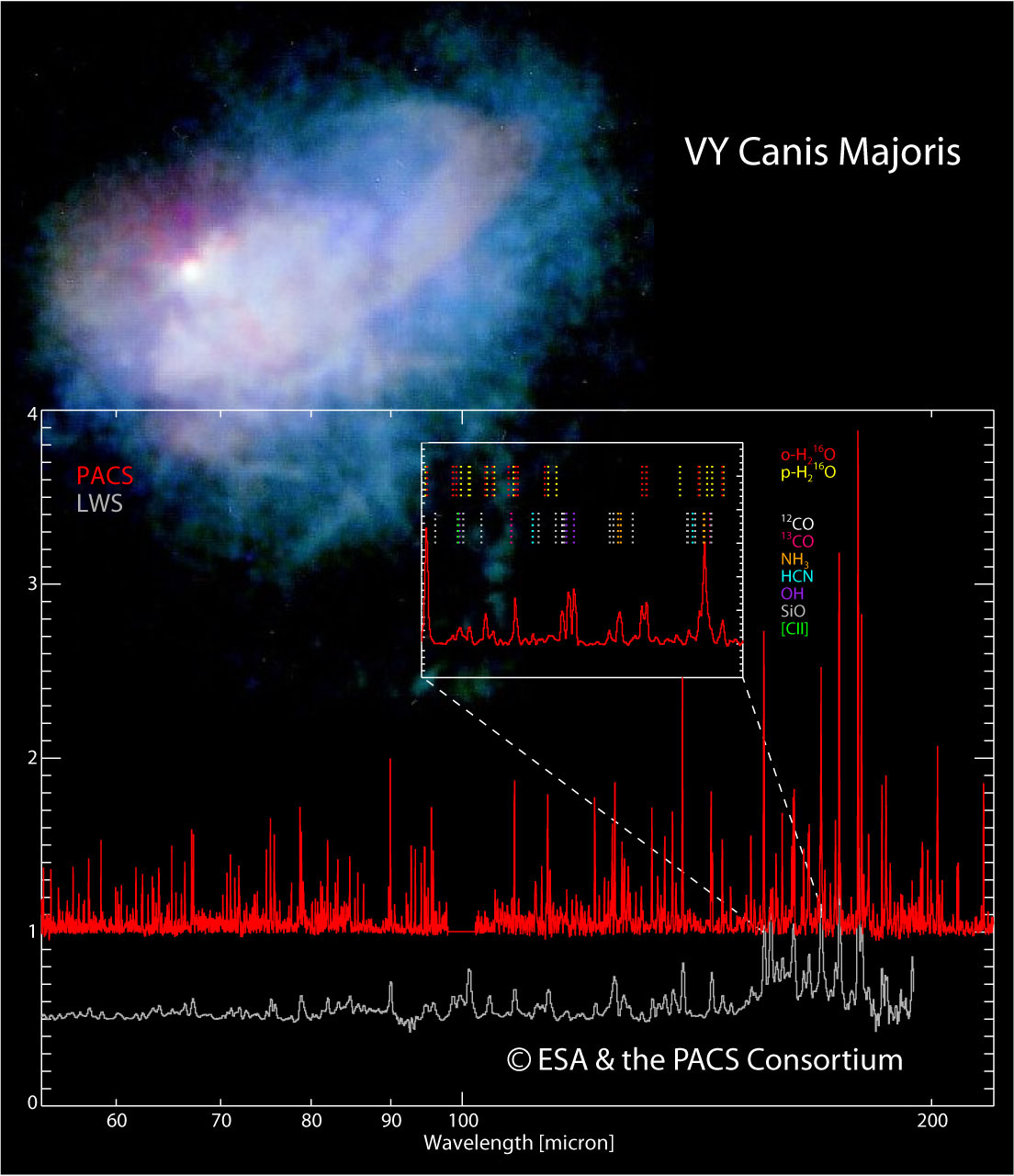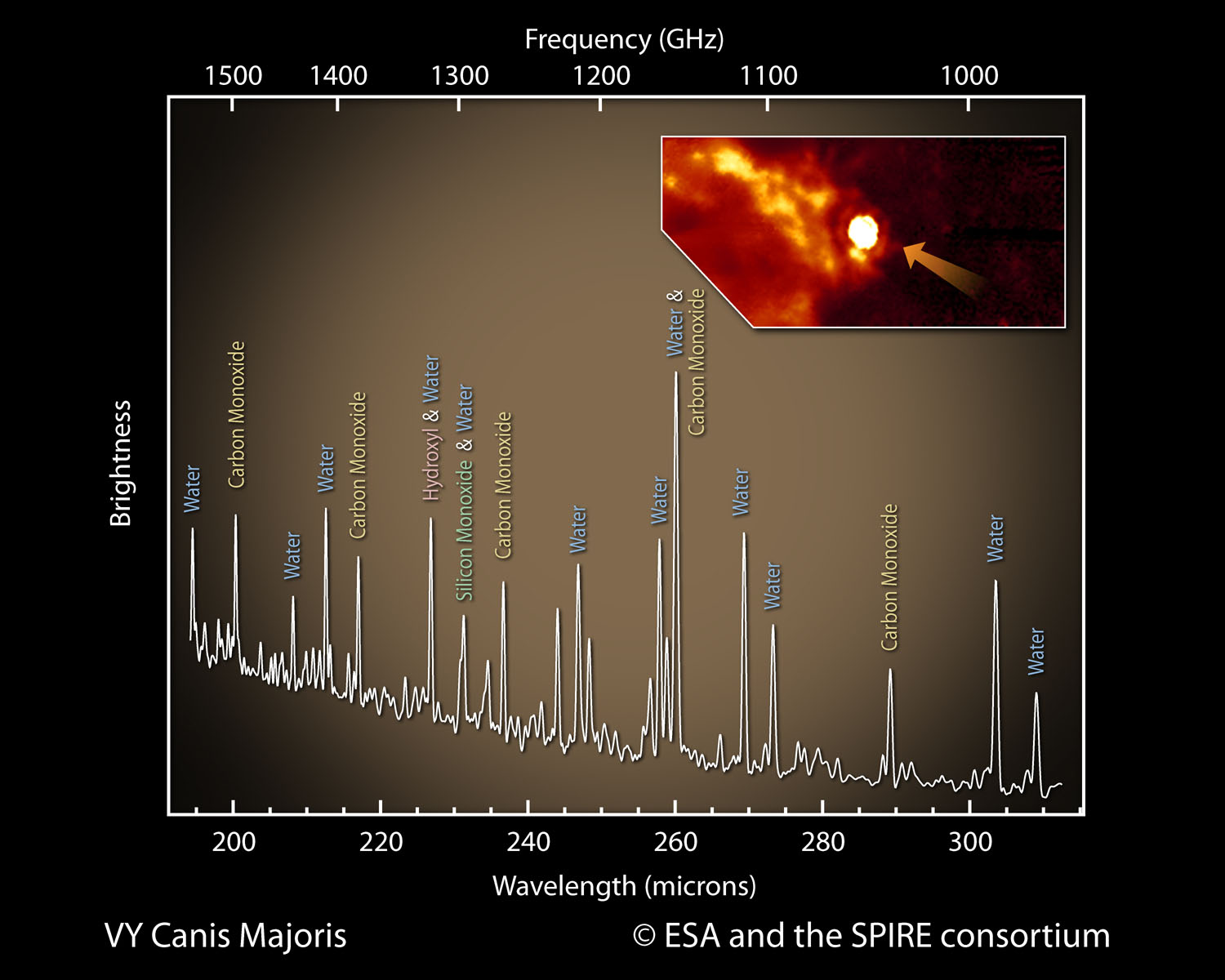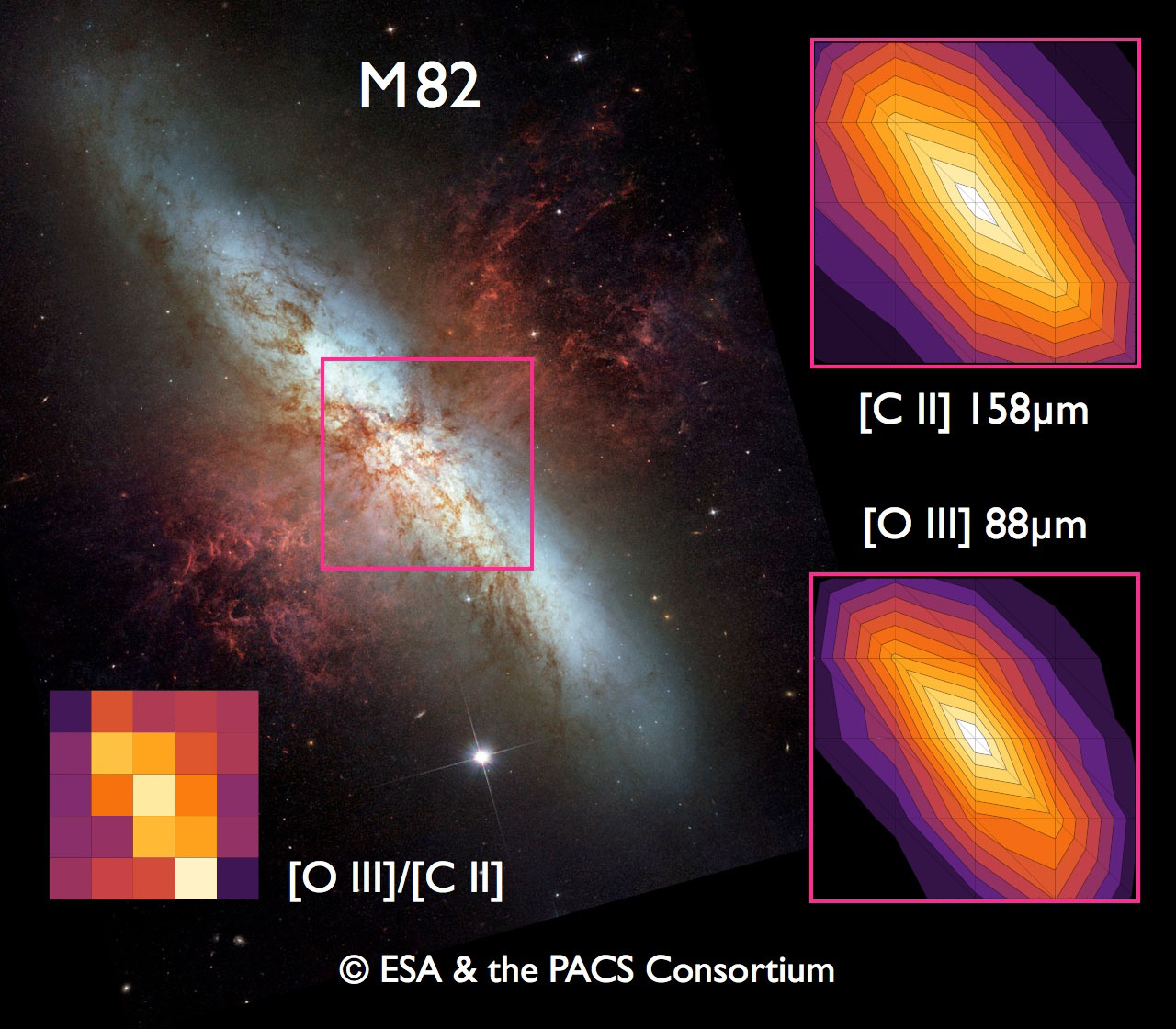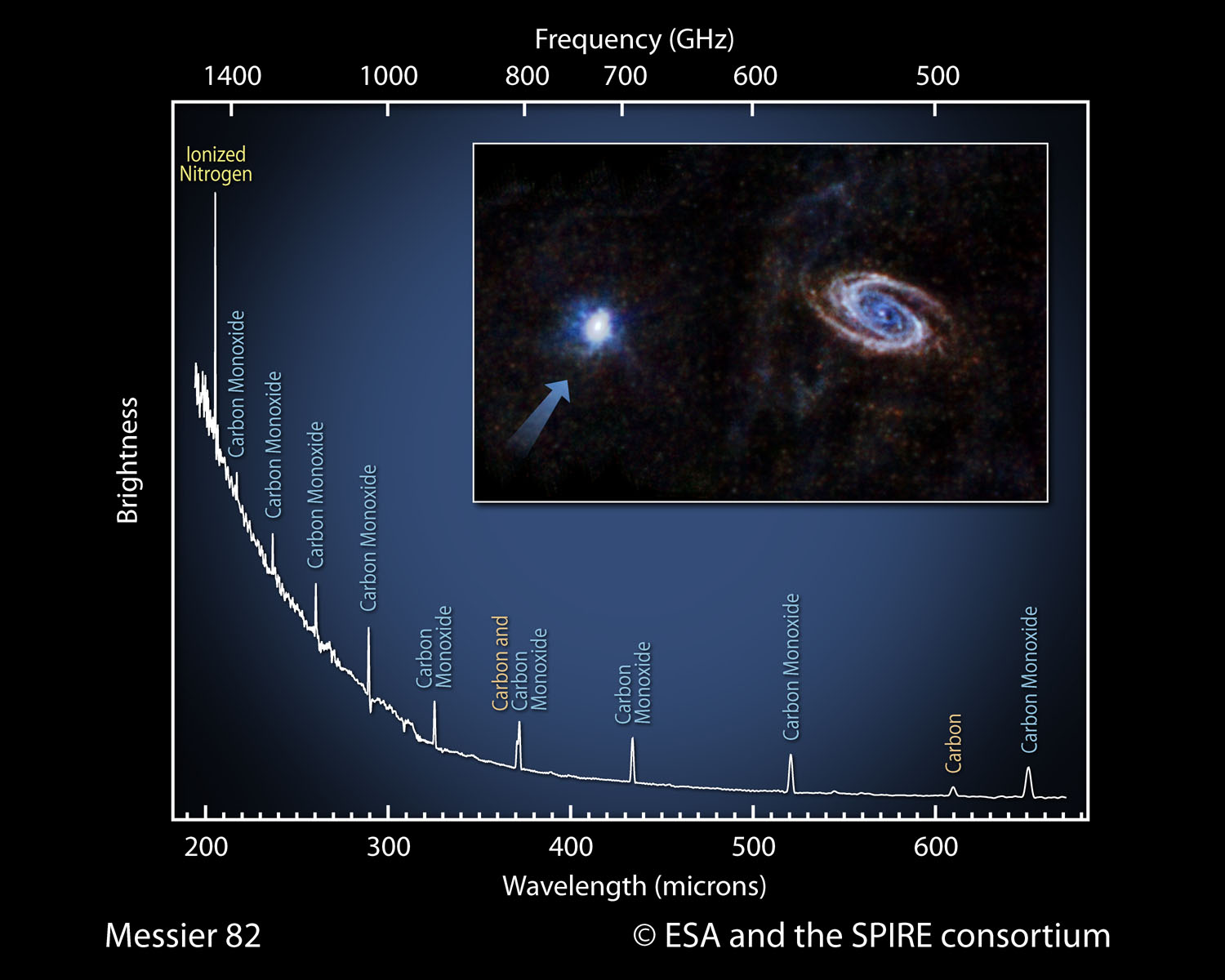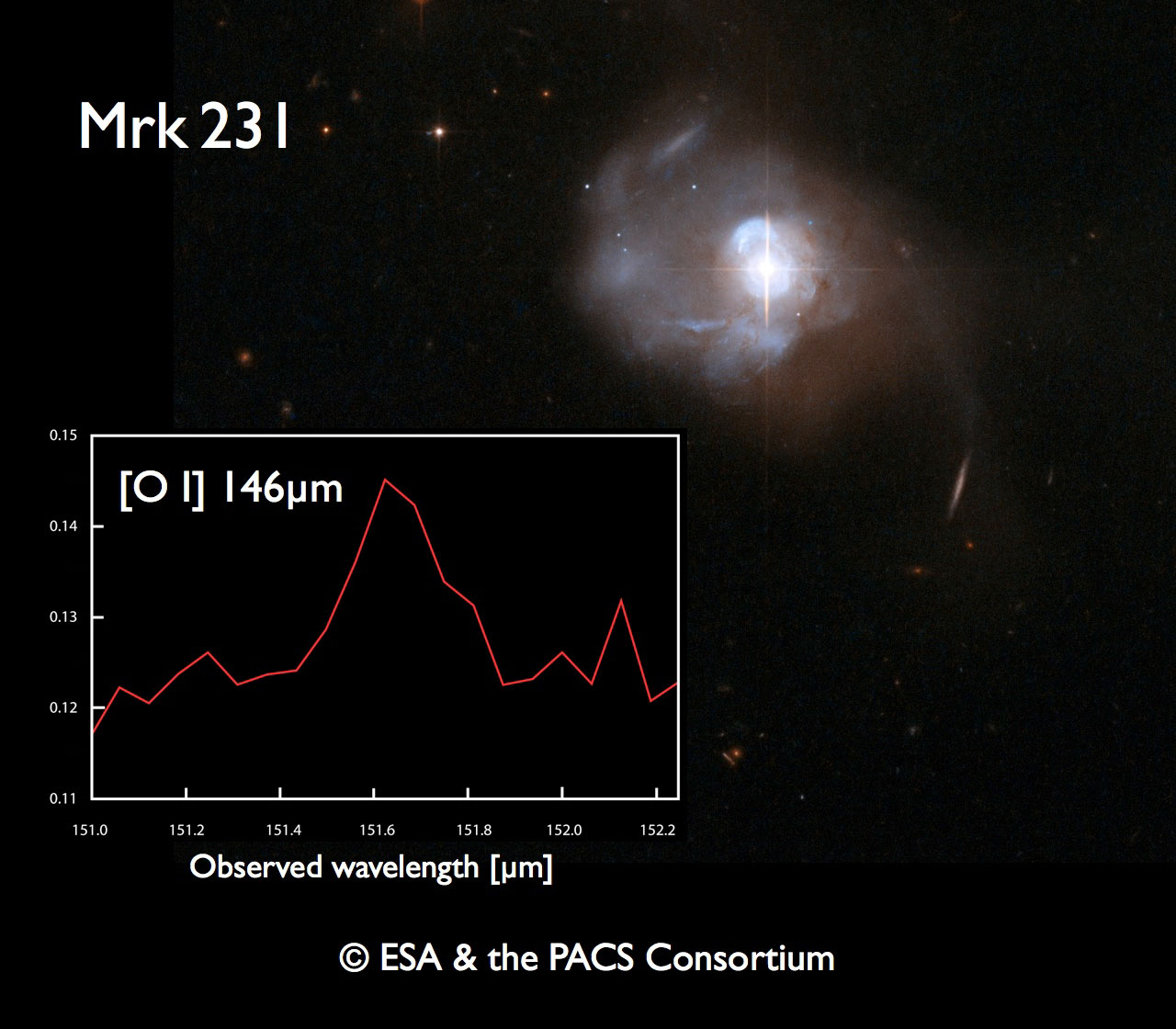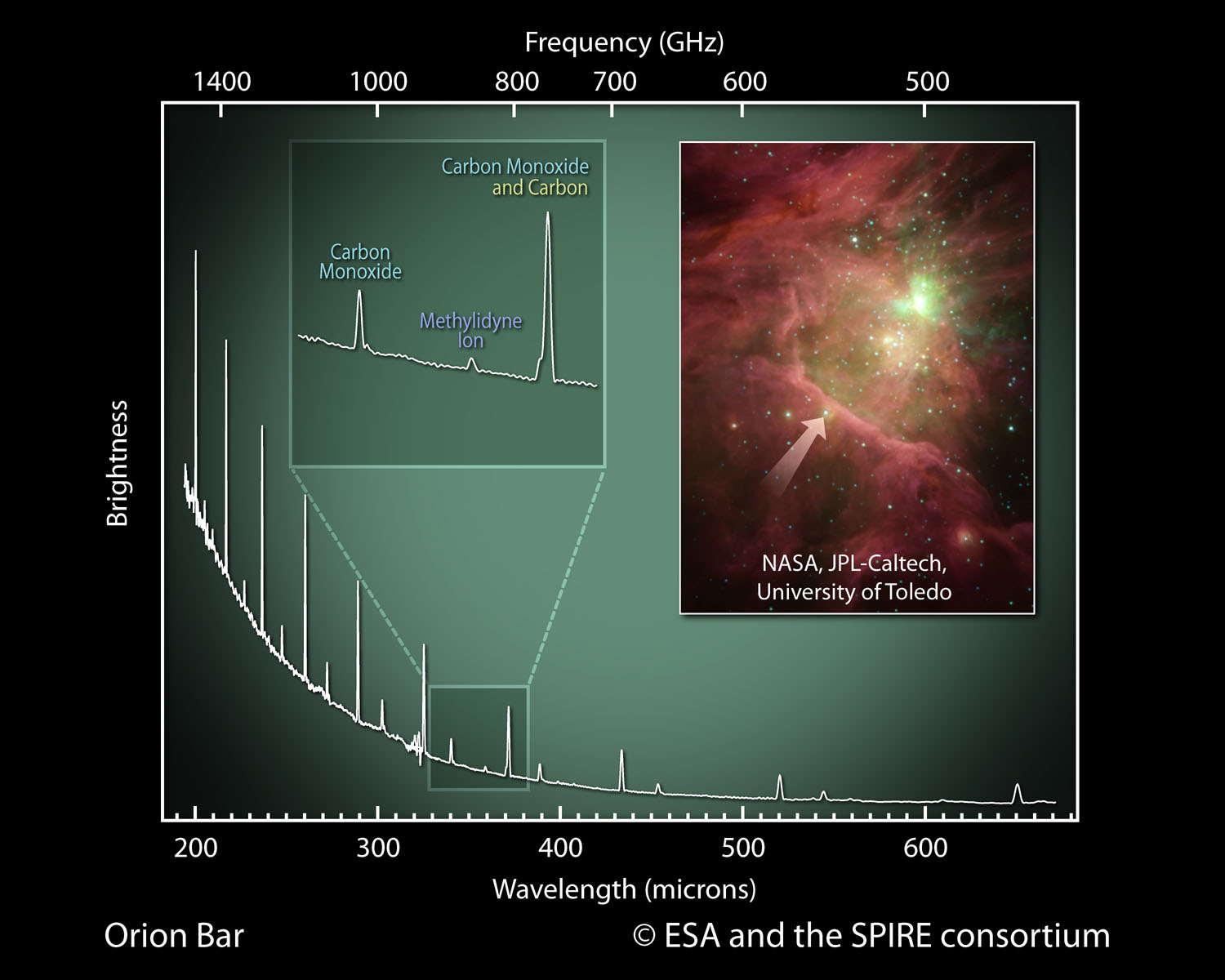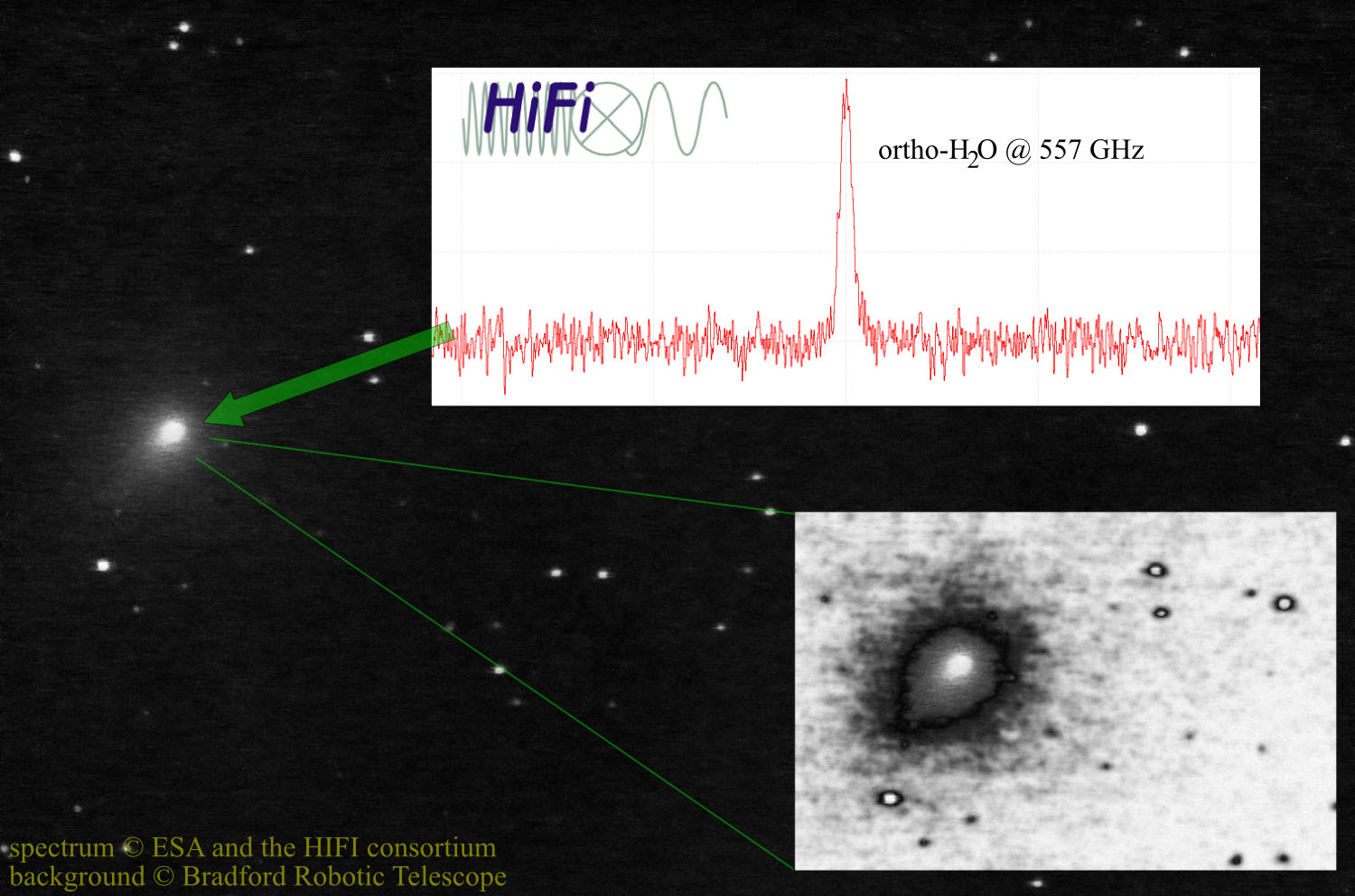Herschel spectroscopy galore! - Herschel
Herschel spectroscopy galore!
In the previous three progress reports documenting Herschel on its way from launch to operational observatory (the 'sneak preview', 'first light', and 'parallel mode') the emphasis has initially been on photometry. Photometry, particularly in the form of scan mapping, first by PACS and shortly thereafter by SPIRE was a natural start. The resulting maps provided early encouraging observational results, and were very important in determining optical and pointing performance. Scan mapping modes were also the first to have been released for performing science demonstration phase (SDP) and more recently also the first routine science phase (RSP) observations.
While some PACS and HIFI spectroscopy were featured in the 'first light', low unstable instrument temperatures in the early mission prevented SPIRE from performing spectroscopy. However, for some time now both SPIRE and PACS have been producing fantastic spectroscopy which will be featured here, the first time for SPIRE.
A note also on HIFI, a plan to bring HIFI back in operation in January 2010 now on the table has recently been adopted (see further the HSC Operations (B)Log).
First SPIRE spectroscopy - submillimetre FTS observations
The SPIRE Fourier Transform Spectrometer (FTS) covers the frequency range from about 445 - 1550 GHz (194 - 672 µm), with a spectral resolution of 1.2 GHz. It provides a complete survey of the source spectrum over that whole wavelength range in a single observation, something that has never been possible with previous submillimetre instruments. This will be invaluable to astronomers in determining the composition, temperature, density and mass of interstellar material in nearby galaxies and in star-forming clouds in our own galaxy. At the same time as measuring the intensities of spectral features from gas atoms and molecules, the SPIRE spectrometer also accurately measures the broad continuum radiation from dust; and with its multi-pixel detector arrays, it can produce spectral maps - full spectra simultaneously for 19 spatial positions over the 445 - 930 GHz range and 37 positions over the 930 - 1550 GHz range.
Several trial observations have been made as part of the commissioning and performance verification of the spectrometer. Whilst a great deal of work needs to be done to devise the best operating parameters, to calibrate the data, and to confirm the sensitivity, it is clear from these initial observations that the data are of excellent quality. They also demonstrate that the spectroscopic capabilities of the three Herschel instruments complement each other as intended.
VY Canis Majoris - the largest known star
VY Canis Majoris (VY CMa) is a red hypergiant evolved star located in the constellation Canis Major ('Greater Dog'). With a size of 2600 solar radii, it is the largest known star and also one of the most luminous ones. It is located about 4900 light years away from Earth, has a luminosity in excess of 105 solar luminosities, a mass in the range 30-40 solar masses, and a mass-loss rate of 2x10-4 solar masses per year. The shell of gas it has ejected displays a complex structure, the so-created circumstellar envelope is among the most remarkable chemical laboratories known in the universe, creating a rich set of organic and inorganic molecules and dust species. Through stellar winds, these inorganic and organic compounds are injected into the interstellar medium, from which new stars orbited by new planets may form. Most of the carbon supporting life on planet Earth was forged by this kind of evolved star. VY CMa truly is a spectacular object, it is close to the end of its life and could explode as a supernova at any time.
Figure 1. VY CMa, a red supergiant star near the end of its life, which is ejecting huge quantities of gas and dust into interstellar space. Left: PACS spectrum (in red) between 50 and 210 µm. In grey, the observation of the ISO Long Wavelength Spectrometer (LWS) is displayed (with an offset of -0.5). Background Hubble Space Telescope image in the optical and near-infrared wavelength as obtained by Smith et al. 2001. The inset shows a zoom into the 156 to 172 micrometer wavelength range. In this short wavelength region, 44 different molecular lines are identified (see coloured thick marks). Right: A portion of the SPIRE spectrum; the inset is a SPIRE camera map of VY CMa, in which it appears as a bright compact source near the edge of a large extended cloud.
VY CMa has been observed by Herschel using both PACS and SPIRE, producing a full survey of its spectrum between 55 and 670 µm (Fig. 1). Herschel, with its unprecedented sensitivity, spatial and spectral resolution in the far-infrared, can detect the "fingerprints", i.e., the spectral lines of the chemical species produced in the gas expelled by this star, revealing an amazingly rich spectrum with hundreds of features due to a variety of different atoms and molecules.
In the PACS spectrum of VY CMa (Fig. 1 left, red) between 50 and 220 µm, thanks to its excellent signal-to-noise ratio, even the weakest spectral features can be identified (see inset). A comparison with data obtained by the Long Wavelength Spectrometer (LWS, in grey) which was on board the ESA Infrared Space Observatory (ISO, 1995-1998) demonstrates the great advances made possible with Herschel and PACS in studying the complex chemistry in this highly evolved phase which is at the end of its "life" as a star.
The SPIRE spectrum, a portion of which is shown (Fig. 1 right), has prominent features from carbon monoxide (CO) and water (H2O). More than 200 other spectral features have also been identified so far in the full spectrum, and several unidentified features are also being investigated. Many of the features are due to water, showing that the star is surrounded by large quantities of hot steam. Observations like these will help to establish a detailed picture of the mass loss from stars and the complex chemistry occurring in their extended envelopes. As in all of the SPIRE spectra, the underlying emission increases towards shorter wavelengths, and is due to the emission from dust grains. The shape of the dust spectrum provides information on the properties of the dust.
In the PACS spectral range, more than 400 spectral lines of which more than 270 are water lines have been detected. The envelope of VY CMa resembles nuclear power plants on Earth, where water is used to cool the environment of the central engine.
Messier 82 - the nearest star-burst galaxy
The Messier 82 (M82) prototype nearby starburst galaxy, about 12 million light years away in the constellation of Ursa Major ('Great Bear'), has also been observed by both PACS and SPIRE (Fig. 2). It is part of an interacting group of galaxies including the large spiral M81 from which material is being stripped by the gravitational interaction with M82.
Figure 2. Left: Hubble Space Telescope image of the starburst galaxy M82 (NASA/ESA/STScI/AURA/The Hubble Heritage Team) with the pink box outlining the area mapped by the PACS spectrometer. The two insets on the right show (colour-coded) intensity maps in the light of spectral lines of carbon and oxygen. The inset in the lower left shows the ratio of the oxygen line over the carbon line. The variation of this ratio reflects the different physical conditions across this galaxy. Right: The SPIRE spectrum of M82. The accompanying image is a spectacular three-colour composite picture of the M81 and M82 pair of galaxies made with the SPIRE camera.
M82 is famous for its spectacular bi-polar outflow or "super-wind", gas and dust driven outwards by stellar winds and supernovae in the galaxies central regions, where stars are produced at a very high rate. The physical conditions in the interstellar medium (ISM) of such a galaxy vary strongly across the different environments. PACS (Fig. 2 left) provides for the first time the necessary sensitivity and imaging capability with sufficient spatial resolution to study these variations in detail. Spectral images from two important tracers of the ISM in the far infrared are shown: line emission from doubly ionized oxygen ([O III]) and from singly ionized carbon ([C II]). The ratio [O III]/[C II] of these two lines, a diagnostic of ionized gas vs. neutral gas drops rapidly going outwards from the galaxy centre along the disk. In contrast to this the ratio drops less when going outward in the super-wind direction.
The SPIRE spectrum of M82 (Fig. 2 right) shows strong emission lines from CO over the whole wavelength range, as well as emission lines from atomic carbon and ionized nitrogen.
Arp 220 and Markarian 231 - giant mergers
Previous infrared space missions discovered that collisions and mergers of gas-rich galaxies glow with the luminosity of a quasar. The incredible far-infrared luminosity of these dust-shrouded mergers known as "Ultraluminous Infrared Galaxies" (ULIRGs) is caused by extremely energetic starbursts, producing hundreds of new stars every year, as well as by accreting super-massive black holes in their active nuclei. Two well-known examples Arp 220 and Markarian 231 (Mrk 231) have been observed by Herschel (Fig. 3).
Figure 3. Left: SPIRE spectrum of the star forming galaxy Arp 220. Right: PACS spectral scan of one of the emission lines detected by Herschel PACS in Mrk 231 is shown superposed on an optical image of this galaxy created using Hubble data from a programme lead by A. Evans (University of Virginia, Charlottesville /NRAO/Stony Brook University).
SPIRE FTS capabilities are demonstrated by a spectrum of Arp 220 (Fig. 3 left), a galaxy 250 million light years distant from Earth with very active star formation triggered by a merger between two large spiral galaxies (like the Milky Way and the Andromeda galaxy). Arp 220 is an important template for understanding even more distant galaxies and galaxy formation in the early universe. The spectrum shows many emission features of CO, and H2O features are seen both in emission and absorption. The inset is an optical image of Arp 220 made with the Hubble Space Telescope.
In addition to intense continuum and strong molecular line emission, starburst galaxies also emit weak far-infrared fine-structure spectral lines. Using PACS on Herschel for the first time these weak emission line signatures from such an object have been measured (Fig. 3 right) in the extraordinary galaxy Mrk 231. This line emission from different atoms and ions is a signature from the neutral and ionized interstellar medium in galaxies and is important to diagnose the dust-enshrouded power sources in ULIRGs. The weak emission line, never before detected in a ULIRG, originates from neutral oxygen located in the interstellar medium of the galaxy. Its ratio with a stronger line of ionized carbon is a good diagnostic of the power source and the conditions in the interstellar medium of the galaxy. Mrk 231 has long tidal tails and a disturbed shape, a typical signature of colliding galaxies, and is located about 600 million light-years away from Earth (in the constellation of Ursa Major).
Orion and DR21 - galactic star formation
While VY CMa illustrates a star close to the end of its life, the Orion nebula and DR21 regions are examples of massive star forming regions (Fig. 4) in our own galaxy, the Milky Way. Observations of regions of massive star formation reveal a rich inventory of organic molecules. These lines give insight in the chemistry and physical conditions in this region.
Figure 4. Left: SPIRE spectrum of one position on the Orion Bar, a region in the Orion nebula in which the gas on the edge of the nebula is partly ionised by the intense radiation from nearby hot young stars. Right: The HIFI spectrum on DR21 reveals the fingerprints of a number of key organic molecules (formaldehyde, carbon sulfide, the formyl ion, the ethynyl radical, the methyladyne radical; HCO+, CH, C2H, H2CO and CS). The inset (left) and background (right) are near infrared pictures from NASA's Spitzer Space Telescope.
SPIRE observations of the Orion Bar (Fig. 4 left) where gas on the edge of the nebula is partly ionised by the intense radiation from nearby hot young stars. Once again, there is a wealth of emission features from CO. The forest of CO features, appearing as the dominating narrow lines, are here seen for the first time together in a single spectrum. They will enable astronomers to estimate the temperature and density of interstellar gas in a manner completely unprecedented in the history of molecular line astronomy. The spectrum also contains the first ever detection of the emission feature at 835 GHz from the molecular ion methylidynium (CH+) which is a key building block for larger carbon-bearing molecules. The exact frequency of this feature has only been recently precisely measured in the laboratory. The study of this feature in a number of regions will shed light on the formation processes and on the existence of CH+. The Orion bar and similar regions are large, and the SPIRE spectrometer's mapping capabilities will be extremely powerful in characterising how the gas properties vary within such sources.
HIFI can for the first time observe the submillimetre spectral regime unhampered by telluric absorption and hence will provide an unbiased inventory of the molecular composition of such regions and new insights in the formation and early evolution of stars. The DR21 spectrum (Fig. 4 right) was obtained by the so-called frequency switch mode. In this mode the local oscillator is tuned between two slightly different frequencies reversing one the two spectra, obtaining two phases, that can later be combined. This way all the observing time is spent usefully integrating on the signal.
Comet Garradd - water in the Solar system
In the everlasting cold and darkness of the outskirts of Solar system, comets move unseen in their orbits. Comets are "dirty snowballs" - collections of small dust grains held together by ice - that were formed some 4.6 billion years ago in cold, outer regions of the Solar system. They represent left-over material from the formation of the Solar system. For most of their lives, comets dwell far from the Sun and hence they represent a rather pristine record of the early conditions from when the Solar system and the planets were formed.
Figure 5. HIFI spectrum of Comet Garradd, revealing a strong water line. Planned HIFI studies will inter-compare the characteristics of water and volatile organic molecules released by different comets in the Solar system as they approach the Sun.
Small perturbations in their orbit can propel comets inwards. When they approach the Sun, the increased heat releases water (Fig. 5) and other molecules from the frozen nucleus, allowing us to measure the composition and characteristics of the comet. Comets may have contributed greatly to the inventory of volatiles such as water on the Earth and other terrestrial planets.
Herschel - a new view of the Universe
Two hundred and nine years after Sir William Herschel's use of a prism spectrometer to discover infrared radiation from the Sun, these results presented here spectacularly demonstrate our ability to obtain a new multi-wavelength view of the Universe. The exquisite sensitivity and quality of Herschel's spectroscopic data will reveal signatures of the diversity and complexity of the birth processes common to the formation of stars and planets, trace the evolution and ecology in our galactic neighbourhood, and allow us to detect molecules in distant galaxies.
Göran Pilbratt (Herschel Project Scientist) based on inputs provided by the Herschel Principal Investigators Matt Griffin (SPIRE), Albrecht Poglitsch (PACS), and Frank Helmich (HIFI), and members of their consortia.
Notes:
The scientific rights of the PACS observations are owned by Key Programme consortia: for VY CMa by the Mass Loss of Evolved Stars (MESS) Key Programme, led by M. Groenewegen; for M82 and Mrk231 by the Survey with Herschel of the ISM in Nearby INfrared Galaxies (SHINING) consortium, led by E. Sturm.
The SPIRE FTS observations were carried out as part of the performance verification of the observatory. The scientific rights of some of these observations are owned by Key Programme consortia: for Arp 220, M81 and M82, the Nearby Galaxies consortium lead by C. Wilson; for VY CMa the MESS consortium led by M. Groenewegen; for the Orion Bar, the Evolution of Interstellar Dust consortium led by A. Abergel.
The HIFI observations were carried out as part of the performance verification of the observatory.
The Herschel Space Observatory is an ESA observatory mission, with science instruments provided by Principal Investigator consortia, open to the entire science community.
SPIRE has been designed and built by a consortium of institutes and university departments from Europe, the USA, Canada, and China under the leadership of Principal Investigator Matt Griffin located at Cardiff University, UK. Consortium members are: UK: Cardiff University, RAL, MSSL-UCL, UKATC, Imperial College London; University of Sussex; France: CEA, OAMP, IAS; Italy: IFSI, University of Padua; Spain: IAC; Sweden: Stockholm Observatory; USA: JPL/Caltech, University of Colorado, NHSC; Canada: University of Lethbridge, Alberta; China: NAOC.
PACS has been designed and built by a consortium of institutes and university departments from across Europe under the leadership of Principal Investigator Albrecht Poglitsch located at the Max-Planck-Institute for Extraterrestrial Physics in Garching, Germany. Consortium members are: Austria: UVIE; Belgium: IMEC, KUL, CSL; France: CEA, OAMP; Germany: MPE, MPIA; Italy: IFSI, OAP/AOT, OAA/CAISMI, LENS, SISSA; Spain: IAC; Hungary: Konkoly; USA: NHSC.
HIFI has been designed and built by a consortium of institutes and university departments from across Europe, Canada and the USA under the leadership of the Netherlands Institute for Space Research (SRON), Groningen, The Netherlands, and with major contributions from Germany, France and the USA. Consortium members are: Canada: CSA, U.Waterloo; France: CESR, LAB, LERMA, IRAM; Germany: KOSMA, MPIfR, MPS; Ireland, NUI Maynooth; Italy: ASI, IFSI-INAF, Osservatorio Astrofisico di Arcetri-INAF; Netherlands: SRON, TUD; Poland: CAMK, CBK; Spain: OAN(IGN), CAB(CSIC-INTA); Sweden: Chalmers University of Technology - MC2, RSS & GARD; OSO; SNSB, Stockholm University - SO; Switzerland: ETH Zurich, FHNW; USA: Caltech, JPL, NHSC.
- Converted a total of (6) center to div.








































 Sign in
Sign in
 Science & Technology
Science & Technology
